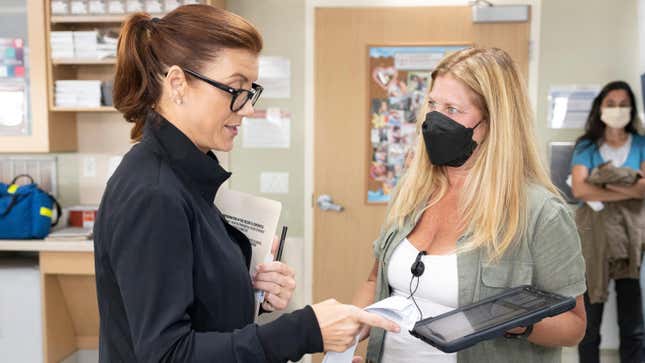How TV Shows Changed Their Abortion Plotlines After Dobbs
We're seeing more scenes of people having to cross state lines for an abortion, running up against gestational limits, and other barriers mimicking the news.
EntertainmentTV

Truth or Fiction? A doctor in Idaho tells a pregnant working mom she has a cesarean scar ectopic pregnancy, a rare but life-threatening medical complication in which the embryo implants onto a c-section scar. Although time is of the essence, the Idaho doctor is nervous about the legal implications of an abortion, because he can still hear a heartbeat, so he refuses to provide her life-saving treatment. The 39-year-old is forced to travel across the border to Washington, but even though she’s accompanied by two doctors, one of whom is an OB-GYN, the van gets stuck in traffic. Her pregnancy ruptures and she bleeds out on the side of the road, leaving behind a husband and a daughter who is about to turn 6.
If this anecdote sounds familiar, you might be a Shonda Rhimes fan: The storyline was a plot in Grey’s Anatomy episode “When I Get to the Border” that aired in November. After the woman dies, Addison Montgomery (played by Kate Walsh) anguishes about her unnecessary death, saying, “How are we supposed to treat patients if we’re hamstrung by laws that are written by people that are so far away from this?”
Her words, when I watched the episode, felt like deja vu. The day before it aired, I had spoken to doctors in Louisiana about how challenging it has become to provide medical care within the bounds of the law. And here I was (in what had started out as a relaxing bubble bath) watching a fictional woman dying from lack of care because a vague abortion law spooked her doctor.
These kinds of scenes used to be pretty rare on mainstream TV—but in the aftermath of the Supreme Court overturning Roe v. Wade, abortion plotlines are starting to look a lot like the actual news. An annual Abortion Onscreen report released Thursday by Advancing New Standards in Reproductive Health (ANSIRH) found that of the 60 abortion plotlines in 2022, a third portrayed legal barriers to abortion access. Last year, only two of the 47 abortion plotlines on TV had anything to do with contemporary barriers to access, like having to travel across state lines.
-

-

-

-

-

-

-

-

-

-

-

-

-

-

-

-

-

-

-

-

-

-

-

-

-

-

-

-

-

-

-

-

-

-

-

-

-

-

-

-








































